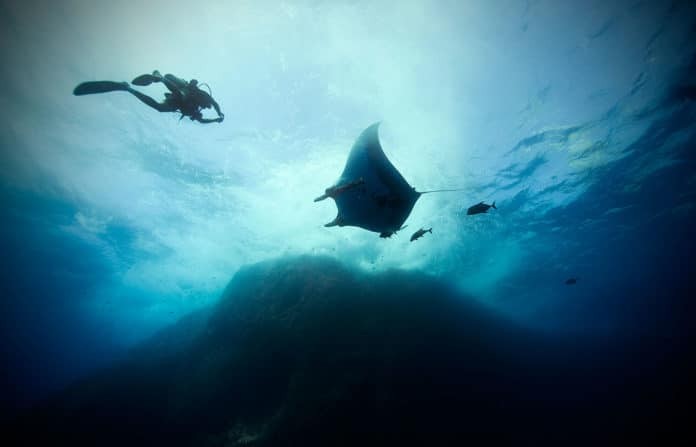There are dive destinations so surreal and magical that they will leave you beaming for days. Revillagigedo Islands is one of them. This unique ecosystem contains an impressive array of large pelagic species such as giant mantas, dolphins, many types of sharks, schooling jacks, tuna, and depending on the time of year, whale sharks and humpback whales.
Revillagigedo Islands, more commonly referred to as Socorro Islands, make up a volcanic archipelago located in the Pacific Ocean 250 miles (400 kilometers) southwest of Cabo San Lucas, Mexico. The area is a protected biosphere consisting of four islands – San Benedicto, Socorro, Roca Partida, and Clarión. Only the former three are generally visited as Clarión is another day’s journey west.
Location
I took this trip with the Solmar V liveaboard based out of Cabo San Lucas in Mexico. Aboard the Solmar V, we were greeted by a smiling crew and a welcome display of shrimp, sushi, and other snacks. The 112 feet/23 feet (35 meters/7 meters) vessel comfortably accommodates 22 guests, and it was inspiring how many solo dive travelers were in our group (including yours truly)!
After the boat briefing and emergency “abandon ship” drill, we were off. Adiós Cabo!
Departure was moments before sunset and, as we exited the marina, we slowed to take in views and photos of El Arco as the sun dipped behind the rocks. Dolphins and a couple whales solicited our attention off the bow, our cell phone service faded, and we were out to sea on what was sure to be an awe-inspiring adventure.
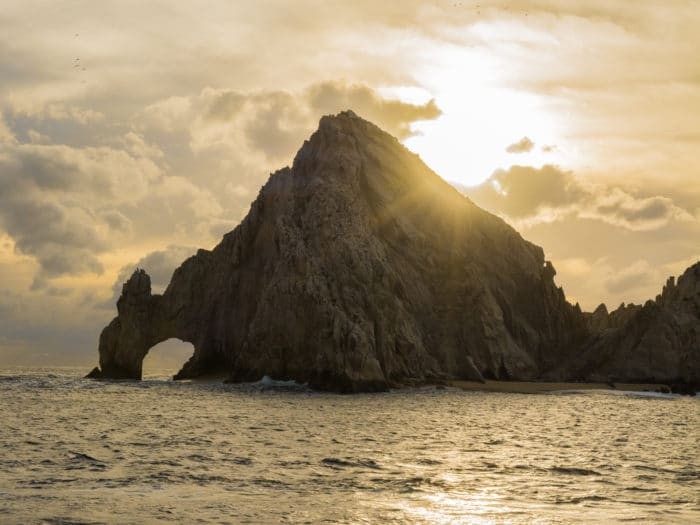
The 23-hour crossing lulled many to a quick slumber and pushed others into an uncomfortable queasiness. The long crossing can be a bumpy ride so word to the wise, macho, and stubborn: Bring your anti-seasick medicine! The rolling will still make you dance circles around the boat, but at least you can enjoy the cuisine, passionate divers’ conversation, and complimentary drinks.
The first day was mainly traveling, so the itinerary consisted of a light breakfast followed by a detailed briefing by the divemaster of the archipelago and life we could expect to see.
The standard rooms are, let’s call them cozy, with storage space enough to stow some clothing, charge a few electronics, and prop open a book. Don’t expect to sit up in the top bunk. The superior staterooms offer a little more space including drawers and are located in the middle of the boat, which has less motion if you are prone to seasickness. A couple of the men opted to sleep on the sun deck, as it was warm and the timing was perfect for a meteor shower. Each of the 12 cabins has its own private bathroom with plenty of hot water.
We arrived at San Benedicto Island in the late afternoon with plenty of light to do a checkout dive. We eagerly geared up and strode off the boat into “Las Cuevas,” a site aptly named for the cave-like swim-throughs. Visibility was minimal, but so were the currents. A few whitetip sharks, a stingray, and a turtle were the highlights, but I was distracted. My camera strobe not firing. Friendly reminder: Double-check your gear before you leave home and if you think you may need something, bring it. With no Wi-Fi, Google is a figment of your imagination, making online troubleshooting impossible. For me, this resulted in the new experience of shooting solely with ambient light.
San Benedicto is a dormant volcanic island that last erupted in the 1950s. The interesting topography consists of a large crater with eroded furrows and a notable lava delta protruding into the ocean. “El Cañón” was the site for our first full day of diving. Large underwater boulders began appearing at about 40 feet (12 meters) sloping gradually to about 80 feet (24 meters) beneath the waves, where we spent most of our bottom time. Over the course of four dives we saw no fewer than five species of sharks, from white- and silver tips, to Galapagos and hammerheads (through those were mainly in the distance). A giant black manta graced us with an acrobatic show, a sneak peek of the days to come. We also saw moray eels, lobster and tropical fish, and were entertained during safety stops by a large bait ball and silky sharks circling under the boat.
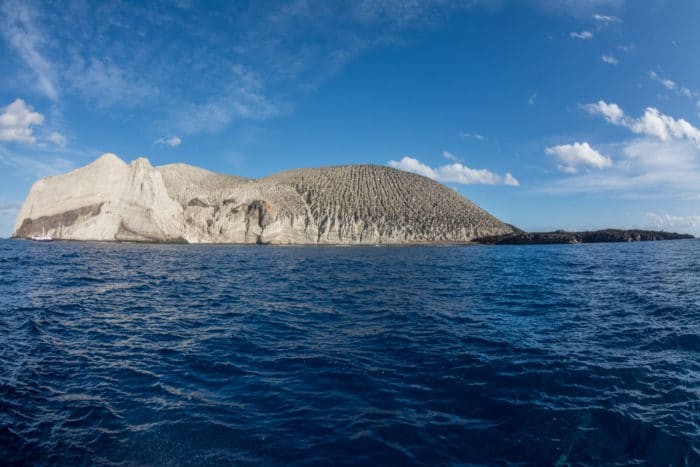
That evening we made the 6-hour passage to Roca Partida, a pinnacle that splits into two separate peaks rising 125 feet (34 meters) out of the water. The smallest island of the group it’s more of an islet at only 300 feet (100 meters) by 26 feet (8 meters) with a steep face only accessible to the numerous seabirds including boobies and gulls that manage the long flight.
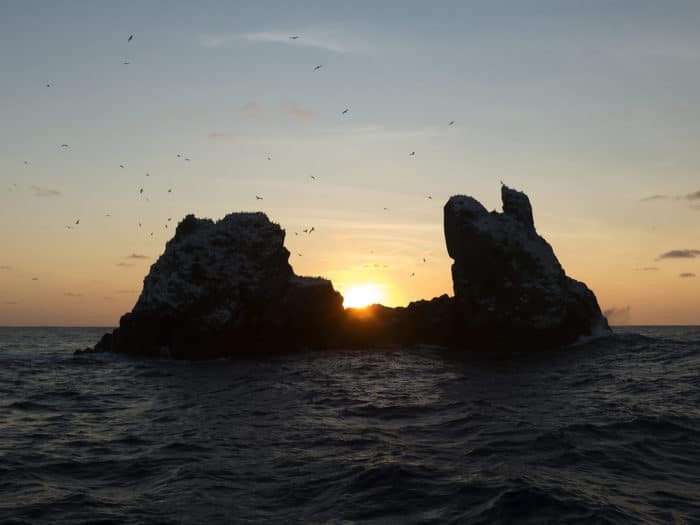
This rendezvous point attracts many sharks, mantas, schools of fish, whales, and, of course, us! There is something powerful and enticing about Roca, and topside I found myself entranced as the waves crashed against the land mass. It was equally commanding when viewed from underwater.
As we back-rolled off the inflatable pangas, the vertical walls underwater became visible. These plunge to a seamount 250+ feet (80 meters) deep. The healthy, hard corals smothering the rock face gave refuge and feasts to eels, lobster, Moorish idols, puffer fish and other small critters. Whitetip sharks ranging in size casually cruised along the pinnacle unphased by our presence, or perched, snuggled on the numerous ledges notched out of walls.
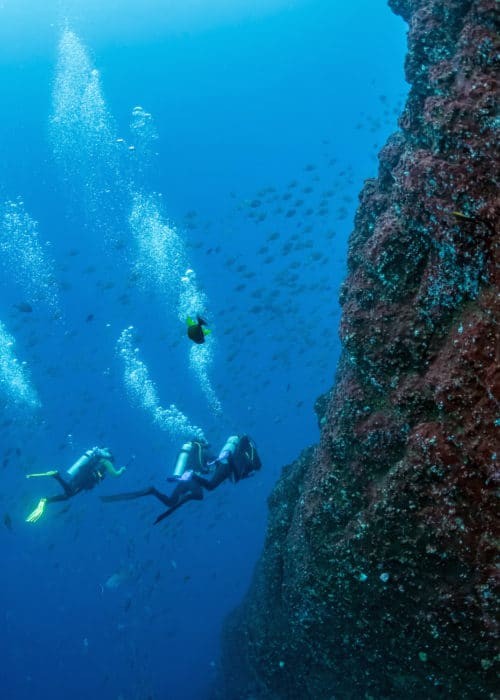
Due to the depths at Roca Partida, our diving there was limited to three dives per day. Both days were enchanting. The island is small enough to easily swim a lap around, though I don’t recall ever approaching the rock during many of the dives as we lingered in blue-water in the presence of several mantas. Their beautiful and elegant motions are unbelievably mesmerizing but tend to distract you and lure you deeper, so beware of your depth. We also saw a few hammerheads in the near distance, large schools of fish, and Galapagos sharks.
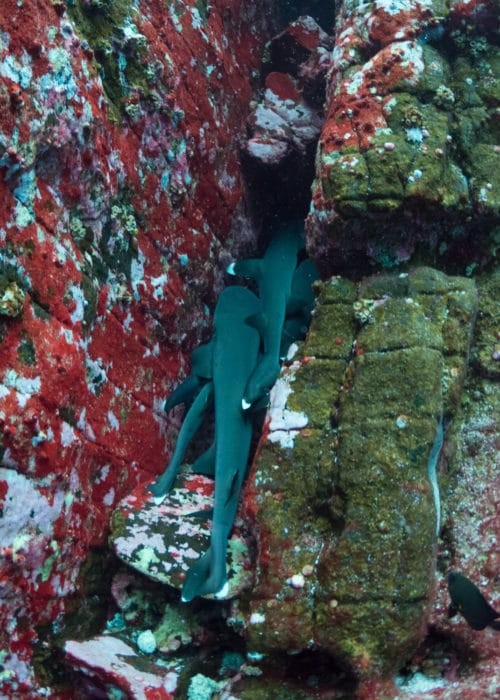
– Photo by Nola Schoder
During the last dive, the water was a light, pale blue, almost milky, not offering much visibility into the beyond. It was eerily reminiscent of my recent trip to Isla Guadalupe, and as I was the tail of our group, I couldn’t help but imagine a great white popping into my vista, although this time I wasn’t in a cage. The energy of this location feels as though something is always about to happen. And it did! A large school of jacks was gazing into their horizon like a frozen wall with massive yellowfin tuna torpedoing through. Within the same visual sweep, a school of barracuda cruised below, and finally, we had it – the false killer whale pod that had been serenading us during the last two dives. Wow! This was a special encounter, something not seen here every day, nor even every trip.
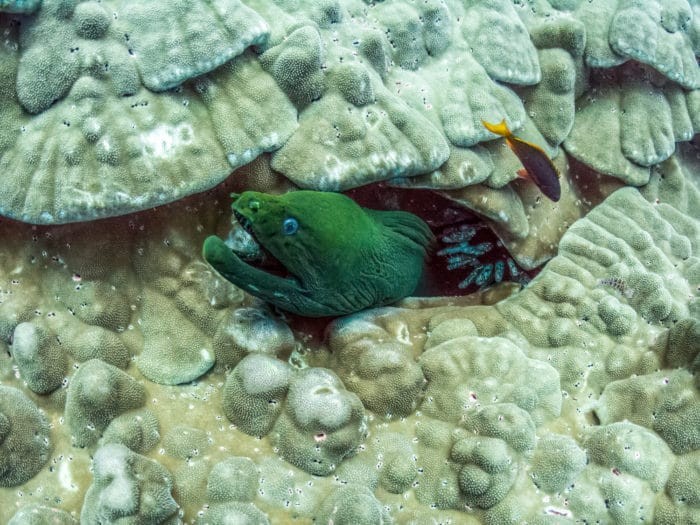
Surface intervals were met with hot chocolate and various fruit bread, deep blue ocean views for miles punctuated by spinning dolphins or mobula rays, and sunbathing on the top deck. Air temperatures were comfortable in the mid-70s F (~24° C), but the occasional cloud covering and winds, especially when the boat was moving, dictated long sleeves or a light jacket.
A 5mm wetsuit is a good option for this destination, paired with 5mm booties and sturdy fins to manage any surge or current. Many divers did get a bit chilly and opted for 7mm wetsuits. Our trip was at the end of December and the water temperatures ranged from 73-77° F (~23-25° C).
Another vibrant sunrise and dolphins frolicking around our boat distracted me from the next morning’s awfully early dive time. We were anchored in a calm cove off Socorro, the largest of the islands (10 miles/16 km by 8 miles/12 km), after a 9-hour overnight passage. The rocky sea cliffs topped with green vegetation set the foreground for Mount Evermann, a volcano rising 3,700 feet (1,130 meters) above sea level, and a Mexican naval station.
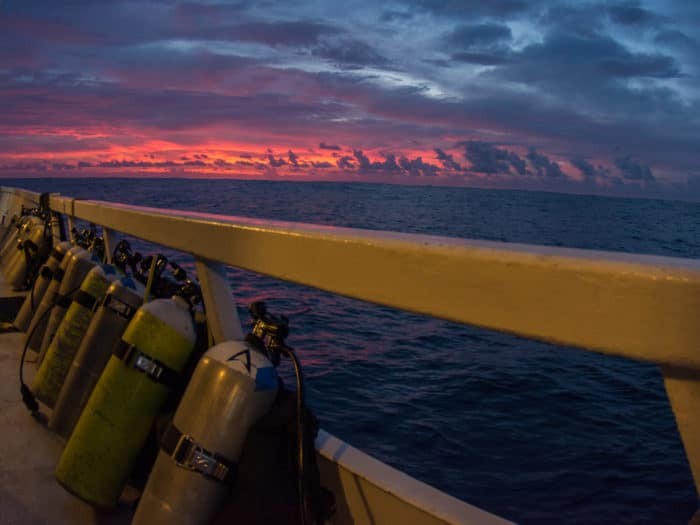
The panga dropped us at “Cabo Pearce”, on the east side of the island, and directly into a pod of playful, bottlenose dolphins. The divers were delighted, dancing with the fun-loving cetaceans. This site is the hunting ground where they teach their young to hunt (and maybe also educate them on human interlopers). They were very engaged with our companionship and are rumored to hang around longer with an enthusiastic, happy-energy group.
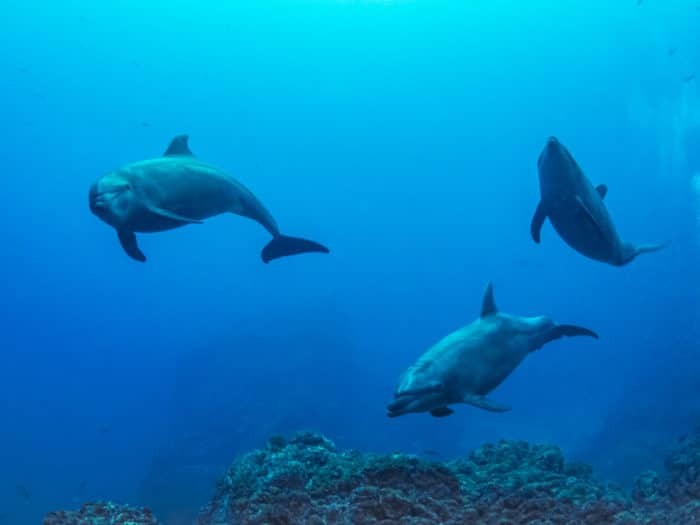
There was a good current at this site, and we grabbed onto the rocky reef waiting for our dolphin friends to return. We were rather deep at 90 feet (~27 meters) and made our way up to around 45 feet (~14 meters) where a manta cleaning station gave us the opportunity to glide with a chevron manta recognizable by the white markings on its dorsal side.
The Revillagigedo Archipelago was designated a UNESCO World Heritage Site in 2016 and here you can see the official plaque underwater. More recently in November 2017, Mexico declared the islands and surrounding waters a National Park thus banning fishing and mining in the area.
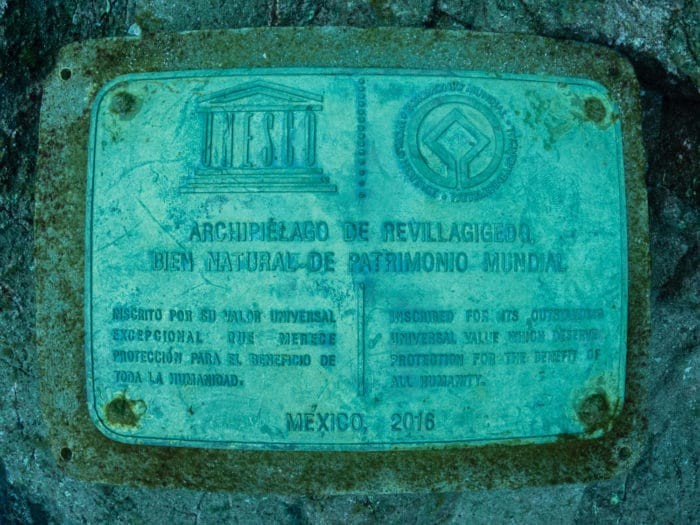
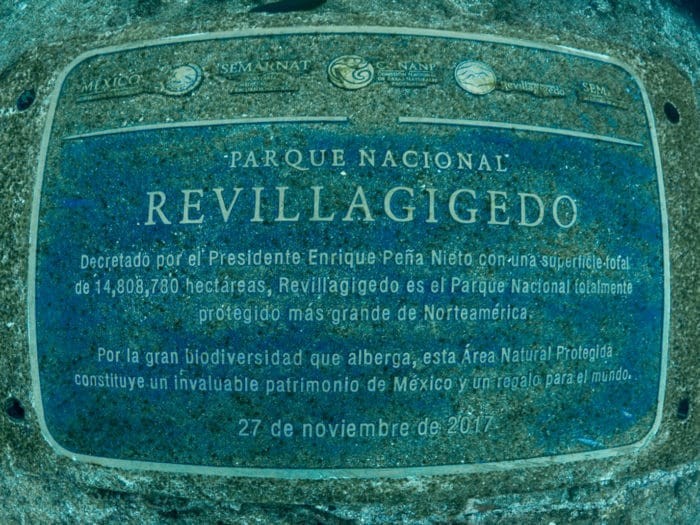
We were done with our three dives by lunch so we could have an early check-in at the Naval base. Officers boarded the boat for an inspection, and 30 minutes later, we were off to the renowned “El Boiler,” a manta cleaning station located on the west side of San Benedicto. The goal was to be the first liveaboard on site, so we could call “dibs” on controlling the schedule and thus nab the first, illustrious dive of the day. We won!
More dolphins. More mantas. More sharks. Did I mention that this place is magical yet?!
Before I could even get my bearings on our first immersion, there were nine or ten dolphins and three mantas swimming around us. The dolphins didn’t stay the whole dive, but they made a good impression.
“El Boiler” consists of an underwater rock formation that plateaus 15 feet (5 meters) below the surface. The waves breaking and spraying above the plateau give the appearance of water boiling. Mantas regularly patrol the cleaning stations here where resident clarion angelfish, wrasse, and other cleaner animals clean their parasites and wounds.
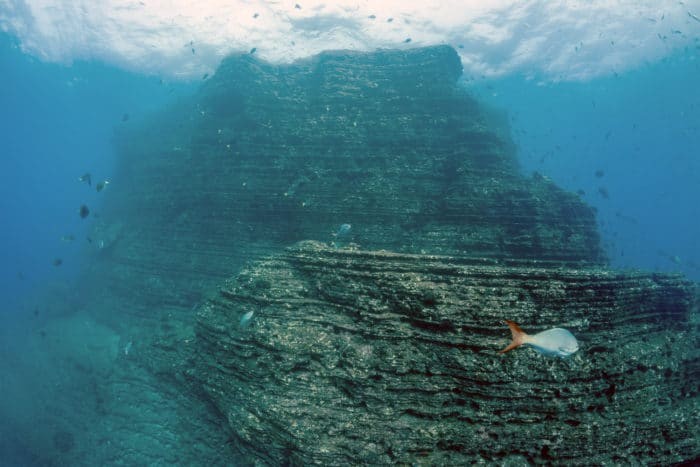
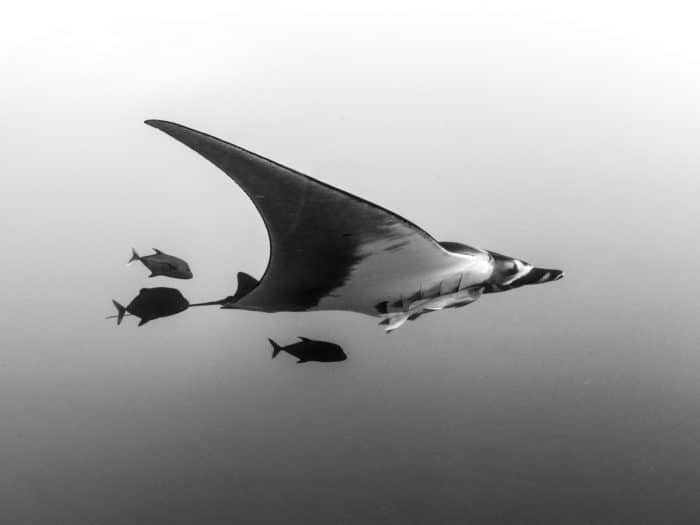
Our last dive featured several mantas, and what a grand finale it was! Their wingspan can reach over 25 feet (up to 9 meters). While their size may be intimidating, they are gentle, harmless creatures. Divers were beyond happy swimming with them and blowing bubbles under their bellies, which the mantas clearly enjoyed as well.
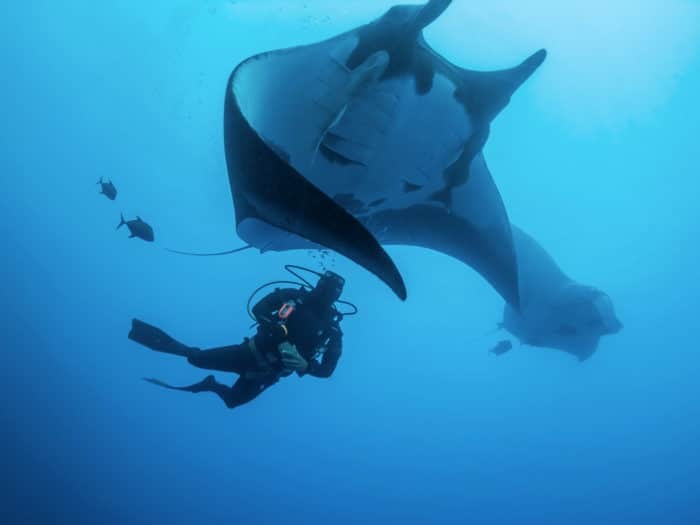
The conditions get a little rough at times, so it is worthwhile to note that this destination is better suited for experienced divers that are comfortable with live drops, considerable depths, surges, and currents. Equally of note is that the crew is hardworking and accommodating, and I knew I was in good hands. It didn’t hurt that Diego, my divemaster, looked like a Latino Aquaman and the idea of him commanding the sharks was comforting and amusing.
Sadly, our trip came to an end and it was time to clean gear and get situated for the return journey to Cabo. We arrived in port in the evening and feasted on filet mignon followed by cheesecake. The final night is spent aboard though there is the option of leaving to explore the city and nightlife. The next morning was a quick made-to-order breakfast followed by farewells!
After visiting Socorro with the Solmar V, I was entranced by the magical encounters, unforgettable moments and great hospitality. Words cannot do justice to the incredibly unique adventure. It’s something you must experience for yourself.
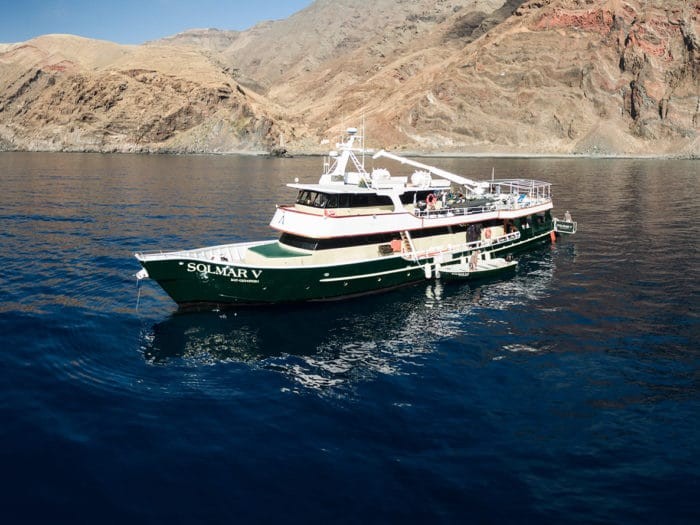
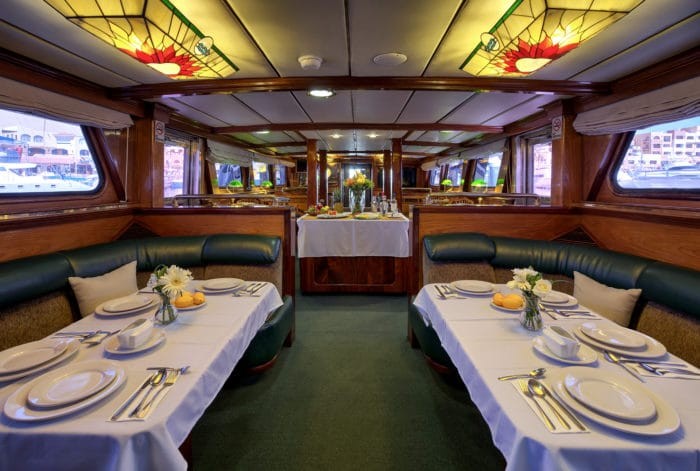
What You Need To Know
How to Get There
Socorro Islands can only be reached by liveaboard departing from Cabo San Lucas, Mexico. The international airport is San Jose del Cabo (SJD), and many major U.S. airlines have direct flights. From there it is a 45-minute drive to Cabo San Lucas. The Solmar V helped arrange pre-paid airport transfer to my hotel for US$20 (~ 17€), or you can get a taxi which would cost five times as much. Their boat departs around 4 pm, so it is recommended to arrive the day before.
When to Go
All the liveaboards run November through May due to weather conditions. During this time there is no shortage of mantas and sharks. The cooler months, January to March, have water temperatures ranging from 70-74° F (~21-23° C) and are when humpback whales are migrating. November, April, and May generally receive warmer water in the high 70s to low 80s F (~26-28° C), and perhaps even whale sharks.
Currency
Mexico’s currency is the Peso though US Dollars and credit cards are widely accepted in Los Cabos. The Solmar V accepts credit cards and US Dollars as well. They do not accept credit cards on board although most everything from port fees, fuel surcharges and National Park fees and even beer and wine are included in their trip price. A local chamber donation of US$15 (~ 13€) is payable in cash upon arrival on the boat. Note that gratuities should be in cash only (15-20% of the trip price is suggested). Other expenses like nitrox, rentals or airport transfers can be paid aboard in cash or in advance by credit card.
Where to Eat
With all the amazing diving, we certainly worked up an appetite. Chef Tony prepared a tasty combination of Mexican, American, and other cuisines, including Mexican BBQ, ribs, pasta, fish entrees and various soups (the tortilla soup was my favorite!), and it was plentiful. Three-course meals with substantial portions were augmented with a constant flow of either sweet bread, snacks, quiches, hot chocolate, fruits, or a salt-rimmed margarita (after the last dive of the day, of course). Feel free to request half portions during meals and don’t forget to leave room for dessert!
On land, there is no shortage of places to eat. There is every type of cuisine and budget for whatever you’re craving.
Where to Dive
I traveled with the Solmar V. They have an excellent crew, many of whom have been navigating these waters for years, and great rates for their value. They run 9- and 11-day trips that include 5 to 7 ½ days of diving with 20-22 to 27-29 dives, respectively. In the Socorro off-season, August through October, they run trips to Guadalupe Island from Ensenada, Mexico, to dive with great white sharks.
Find Out More
You can find out more about the Socorro Liveaboard with Solmar V by visiting their website.

